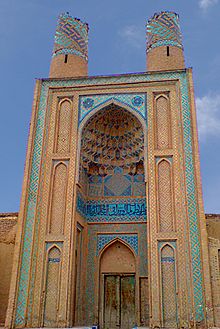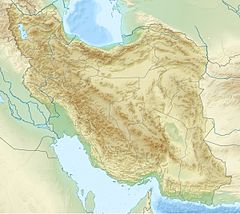Jameh Mosque of Ashtarjan
| Jameh Mosque of Ashtarjan | |
|---|---|
 | |
| Religion | |
| Affiliation | Shia Islam |
| Province | Isfahan Province |
| Location | |
| Location | Isfahan Province, Iran |
| Geographic coordinates | 32°28′33″N 51°28′45″E / 32.4759245°N 51.4791431°E |
| Architecture | |
| Type | Mosque |
| Completed | 1316 |
| Minaret(s) | 2 |
Jameh Mosque of Ashtarjan (Persian: مسجد جامع اشترجان) is a mosque in Ashtarjan, Iran, located 36 kilometers south-west of Isfahan.
History
[edit]Commissioned by an Ilkhanid administrator from Ashtarjan and dated by two separate inscriptions to 1315–16, this mosque has survived in excellent condition. Construction appears to have been swift, executed in phases over a brief period. The calligraphy inside the mosque mentions Ahmad ebn Banna and Haji Mohammad Kashi Tarash as the builders in charge of construction of the mosque. One of the main reasons for this mosque’s survival after more than seven centuries is the metal wires that are placed inside the walls of the mosque that hold it together.[1]
Patronage and Political Context:
[edit]The inscriptions reveal the complex political landscape of the Ilkhanid period. While the mosque was built under Oljeitu's officially Shi'ite rule (evidenced by the inclusion of the Twelve Imams' names), its construction was commissioned by Fakhr al-Dunyd wa'l-Din Muhammad b. Mahmfd b. 'Ali al-Ushturjdni, identified as a mustawfi and munshi, rather than a high-ranking vizier. His inflated titles, like "King of the Viziers in the Universe," highlight the changing nature of political authority during this period.[2]
Specifications
[edit]The mosque has an area of 1500 square meters, and has two northern and southern gates. The northern gate is 13 meters tall and surrounded by remnants of two brick minarets that are decorated with turquoise tiles. Only one third of these minarets survive; they were constructed in such a way that swinging one minaret would cause the swinging of the other one. The southern gate of the mosque is 7 meters tall and decorated with colorful plasterwork.[1][3]
The decoration is of greater importance than the primary structure. The diversity of patterns, materials, and combination of materials employed in the decoration represent a compendium of decorative techniques from around the country. Exposed brick is found only in the arcades, although possibly this area originally had a plaster coat as is employed extensively in the rest of the structure. The plaster is carved in a variety of decorative designs, including geometric patterns; floral motifs in high relief; simulated brick bond, and brick end-plugs – in some areas arranged to configure rectangular kufic inscriptions. On the sanctuary walls and dome, traces indicate that plaster was painted in a vivid array of colors. The lofty stucco mihrab describes an uncommon proportion, reaching the zone of transition. Across the interior of the dome, decorative terracotta elements form eight radial ribs; diverse painted plaster patterns fill the interstices. The northern entrance portal is lavishly decorated with mosaic faience, glazed and unglazed terracotta.[4][5][6]
See also
[edit]References
[edit]- ^ a b "IRNA". Irna.ir. Retrieved 2010-03-29. [dead link]
- ^ "Summon 2.0". aucegypt.summon.serialssolutions.com. Retrieved 2024-11-18.
- ^ "Digital Library". Cgie.org.ir. Archived from the original on 2010-11-25. Retrieved 2010-03-29.
- ^ Lisa Golombek and Donald Wilber, The Timurid Architecture of Iran and Turan (Princeton: Princeton University Press, 1988)
- ^ Arthur Upham Pope, "The Fourteenth Century", in A Survey of Persian Art ed. Arthur Upham Pope and Phyllis Ackerman. (Tehran: Soroush Press, 1977), 1079–1082.
- ^ Donald N. Wilber, The Architecture of Islamic Iran, (New York: Greenwood Press, 1969).

















